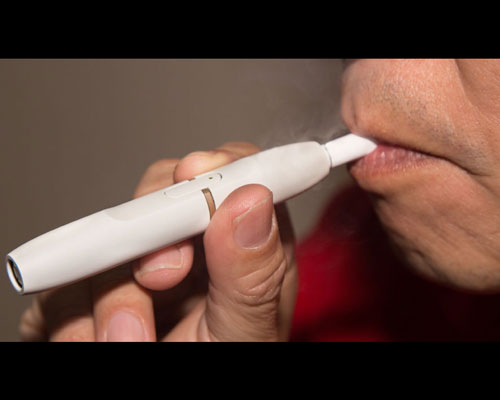Melissa Kress
10/30/2017
CSNews

consumer using heat-not-burn product
NATIONAL REPORT — In June, global market research company Euromonitor International painted a gloomy future for combustible cigarettes. Its analysis found that in 2016, for the first time in decades, the value of the global cigarettes category as a proportion of total tobacco sales fell below 90 percent and by 2021, it will drop to 86 percent. Its data also predicts that the global cigarettes market will record a $7.7-billion loss by 2021.
While combustible cigarette sales decline, the same research highlights growth in the use of vapor products and further changes to come within this segment.
“The continued growth in vapor products and, in particular, the emergence of heated tobacco as a viable alternative mode of consumption represent the major element of disruption for the tobacco industry,” said Shane MacGuill, head of tobacco research at Euromonitor International.
In fact, according to the firm’s research, the struggles of the global cigarettes category will be offset by $13.2-billion growth in heated-tobacco products sales by 2021. Heated tobacco will be the fastest-growing tobacco category in the next five years, reaching $15.4 billion in sales by 2021, up from $2 billion in 2016 — a 691-percent increase.
“We believe that heated tobacco will gain a solid presence in at least 35 global markets by 2021, accounting for a share of 3.5 percent of total global cigarettes and heated tobacco value. Heated tobacco prospects are strong and strengthening. On this evidence, it is truly a coming force in global tobacco,” MacGuill explained.
As their name suggests, heat-not-burn products heat tobacco rather than burning it, which research has found significantly reduces both the number and the levels of harmful and potentially harmful constituents (HPHCs) generated by tobacco products.
Several tobacco companies are already working toward what could be the new normal in the industry.
Earlier this year, Philip Morris International (PMI) reported that more than 1 million smokers have already converted to its iQOS heat-not-burn product. PMI has found success with iQOS on the international stage and is looking to build on that success by bringing the product to the United States. If approved, Altria Group Inc.’s operating company Philip Morris USA has an exclusive license to sell iQOS in the U.S.
Fellow tobacco company British American Tobacco (BAT) is likewise making inroads with its own heat-not-burn product, Glo. BAT, which closed on its acquisition of Reynolds American Inc. in July, plans to submit an application with the FDA to market the Glo product in the U.S. next year.
A NEW CHAPTER IN A CONTINUING STORY
David Bishop, managing partner of Balvor LLC, a sales and marketing firm that provides analytic, consulting, research and sales support services to retailers, product suppliers and other organizations across foodservice and retail, agrees that alternative tobacco products is where the industry is headed.
“I think inevitably you will continue to see the industry move in the direction of alternative tobacco products,” he said, adding that manufacturers will lead the way.
The tobacco space saw this same kind of evolution 10-plus years ago with the move to smokeless tobacco, Bishop pointed out, and another recent chapter in the evolution of tobacco was the introduction of electronic cigarettes.
“When e-cigarettes came out, there was an incredible rush to try them, and that rush to try the product really was a reflection or indication that those tobacco users were interested in trying to find an alternative to the traditional combustible cigarette,” he said.
From a perception standpoint, the e-cigarette was originally thought of as a product that would likely, in the consumer’s mind, be less harmful to them while still allowing them to satisfy their ritual and cravings. However, it became clear that it was important the experience delivered the same level of satisfaction, which the early products were not delivering — leading adult tobacco consumers to return to combustible cigarettes, he explained.
In late 2014, Reynolds American Inc. re-introduced a heat-not-burn product, Revo, which had previously been tested as Eclipse. Revo’s initial test was “a very short-lived test,” according to Bishop, but it “illustrated that there is a growing recognition within the industry that a high percentage of current smokers have a desire to quit smoking.”
Younger adult smokers are more inclined to be interested in using alternative tobacco products and are less loyal to combustible cigarettes, he added.
“The current regulatory environment in the United States, with taxation and legislation at the local, state and federal levels, continues to point to the fact that something less risky needs to fill that space,” Bishop said. “I think the manufacturers see what is coming five, 10, 15, 20 years down the road and they are working toward that.”
The heat-not-burn technology found globally, like in iQOS, has demonstrated that it is able to provide a viable alternative to combustible cigarettes, according to Bishop. “It enables a tobacco user to have a similar ritual, taste and experience,” he noted.
Subscribe to our free mailing list and always be the first to receive the latest news and updates.
